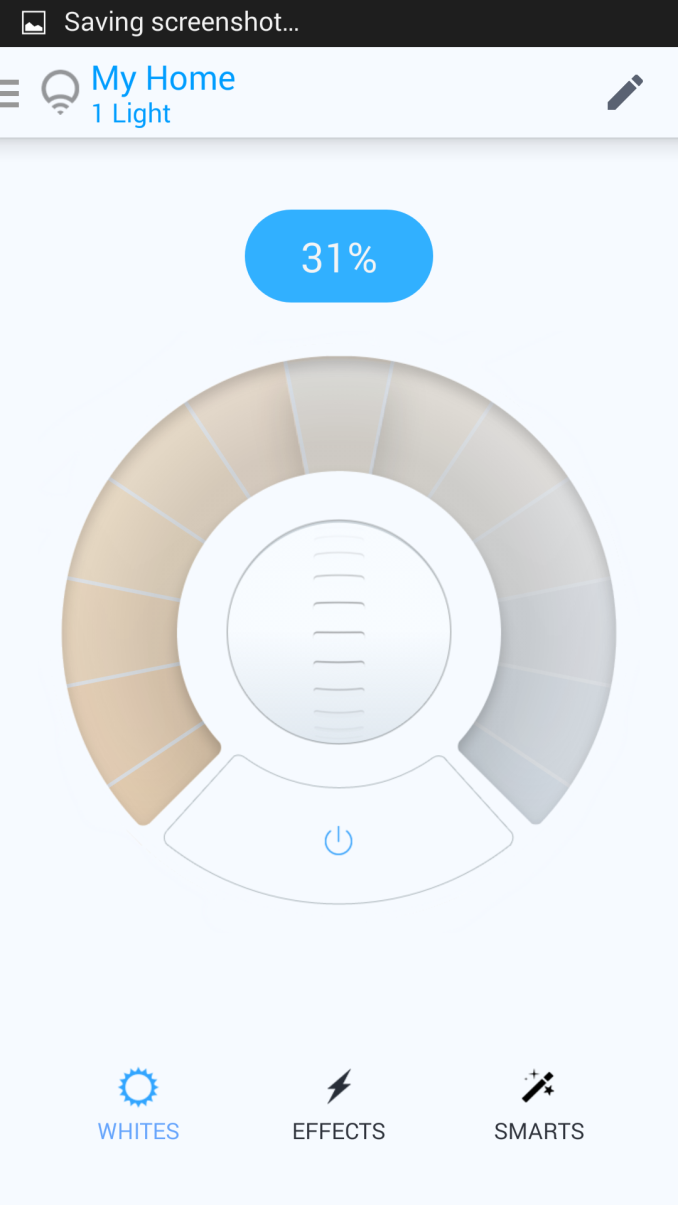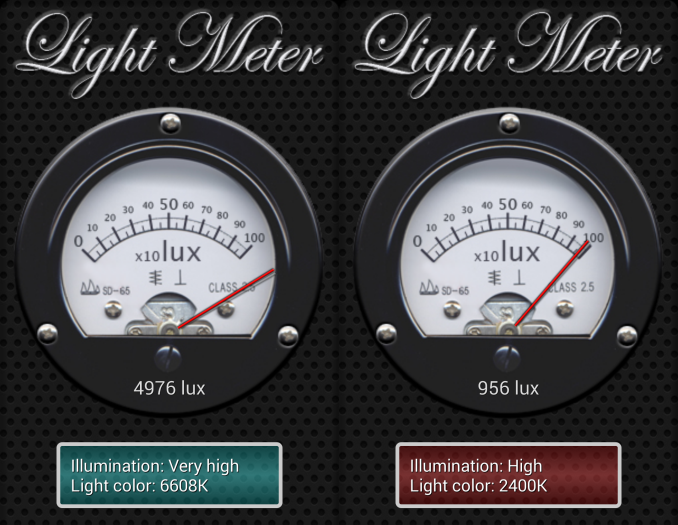LIFX White 800 Smart Bulb Review
by Ganesh T S on June 12, 2015 9:55 AM EST- Posted in
- Home Automation
- Wi-Fi
- Qualcomm Atheros
- LIFX
Setup, Usage and APIs
The setup process for the LIFX White 800 is similar to most other IoT devices. The unit boots up with its own SSID. A mobile device (iOS or Android) with the LIFX app pre-installed is made to connect to it. A LIFX account is associated with the device. It enables control over Internet with communication via LIFX's servers.
Dimming is achieved via the core thumb-wheel in the app's home page. Color temperature can be tuned using the dial around it.
Many of the other app features such as themes are applicable to the multi-colored light bulbs. However, the scheduling feature works well with the White 800.
On the whole, the app is straightforward and easy to use.
We measured color temperature of the light bulb's out with a Samsung Galaxy S4 using a Light Meter app. The color temperature dial in the LIFX app was set to the two extreme temperature points for the screenshots below.
The color temperature measured as per the specifications and was obviously evident to the naked eye.
LIFX has been quite popular with power users. The communication protocol was reverse engineered, and there are multiple open source projects based on them. lifx-http, lifxjs and lifx-java are examples. Firmware v2.00 messed up many of these apps. However, it also brought along support for the official HTTP APIs. The APIs are a very good starting point and allow simple apps, but, unfortunately relies on the LIFX's web servers being up and the user's Internet connection being active (it is cloud-only). Recently, the official LAN-only documentation was updated. Hopefully, local HTTP APIs are made available soon - either officially from LIFX or via third-party developers.
Initially, LIFX didn't appear power-user friendly after the launch of v2.00 of the firmware, but things are slowly getting better with the publishing of the LAN protocol. The main item in our wishlist with respect to usage / APIs is a web interface for the bulb - the ability to control the light temperature and brightness using a web browser. This interface could also double up as an official 'mobile app' for platforms such as Windows Mobile.
























55 Comments
View All Comments
mikato - Friday, June 12, 2015 - link
The very small standby power mode it has now makes it more interesting as you can leave its power switched on and use the network to control it fully - making for a possibly more networked home in the future.ddriver - Friday, June 12, 2015 - link
It could actually have tremendously lower idle power use. That microcontroller is a ridiculous overhead for light bulb, it would be proportional to a quad socket 48 core xeon system with 128 gigs of ram for a machine dedicated to emails...The more elegant solution would be a single control unit for all lightning as well as other home automation, "smart bulbs" are a clumsy and inefficient solution. I'd rather have a "smart home" than a "dumb home with smart light bulbs".
MrSpadge - Friday, June 12, 2015 - link
Agreed - I think it would make more sense to include a small controller in th lamp itself, which will contain several bulbs. Which themselves will fail at some point and get replaced by the next ones.Solandri - Saturday, June 13, 2015 - link
Actually, it sounds like we need a new electrical standard. Kinda like the converse of PoE where you send power along cabling initially intended for network signals.A low bandwidth (so as to not cause widespread high-frequency interference) powerline ethernet standard should allow you to plug in "smart" bulbs into a home's standard electrical sockets, and have them controlled via a central control station which communicates with the bulbs over powerline ethernet. Only the control station would need wifi connectivity so you could control it. The individual bulbs would only need to receive instructions next time they were turned on and announced themselves to the control station, thus eliminating the always-on power draw of putting a wifi receiver onto every light bulb.
Navvie - Monday, June 15, 2015 - link
Something like X10?Zefeh - Friday, June 12, 2015 - link
I could see something as simple as the ESP8266 WiFi module as something that you could use instead of what they have. Load it up with the customized LUA firmware on the net and you have a pretty decent cheap small Microcontroller that can run LUA scripts with rx/tx WiFi comm, 2 GPIO's (some revisions) for 3.3 volt operation and around 23kb flash to mess with. Low power and cheap at 5 bucks a piece!Slapping an Cortex-M4 on there is ridiculous I agree. House automation systems should have a comm base that does all the decision making. The bulbs just need to communicate and turn on/off/dim.
Another interesting thing to think about is power wire communication. Had a prof. In college working on it, working on transmitting signals through already in place infrastructure and then just making the end points like lightbulbs understand what's said and complies with the request. Interesting concept to think of, very similar to the household WiFi power plug adapters.
boozed - Friday, June 12, 2015 - link
I'd love to have lightning in my house but my friends disagree.Wwhat - Saturday, June 13, 2015 - link
" I'd rather have a "smart home" than a "dumb home with smart light bulbs"."Well I'm sure daddy will buy you one..
ddriver - Saturday, June 13, 2015 - link
Because that's how you get stuff?chrysrobyn - Friday, June 12, 2015 - link
I could get really excited about this and deploy 10-20 throughout my house, if they could automatically change the white color based on the time of day. I'm really curious about the research into circadian rhythms getting input from light color and I'd like to try it out at home.